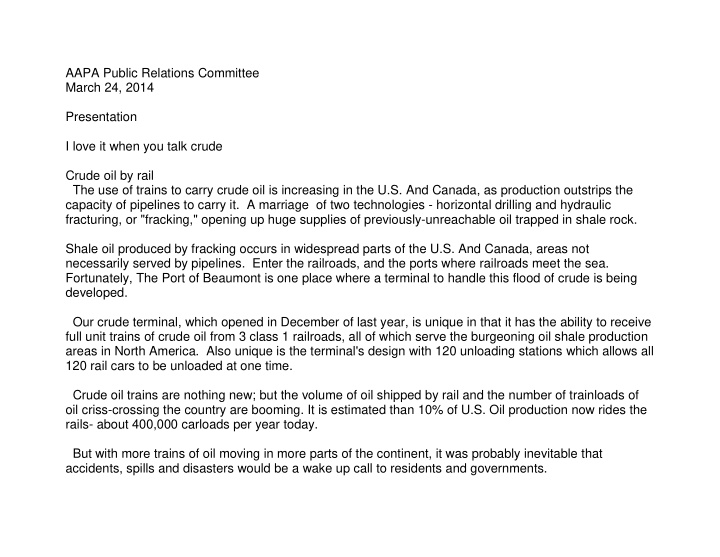



AAPA Public Relations Committee March 24, 2014 Presentation I love it when you talk crude Crude oil by rail The use of trains to carry crude oil is increasing in the U.S. And Canada, as production outstrips the capacity of pipelines to carry it. A marriage of two technologies - horizontal drilling and hydraulic fracturing, or "fracking," opening up huge supplies of previously-unreachable oil trapped in shale rock. Shale oil produced by fracking occurs in widespread parts of the U.S. And Canada, areas not necessarily served by pipelines. Enter the railroads, and the ports where railroads meet the sea. Fortunately, The Port of Beaumont is one place where a terminal to handle this flood of crude is being developed. Our crude terminal, which opened in December of last year, is unique in that it has the ability to receive full unit trains of crude oil from 3 class 1 railroads, all of which serve the burgeoning oil shale production areas in North America. Also unique is the terminal's design with 120 unloading stations which allows all 120 rail cars to be unloaded at one time. Crude oil trains are nothing new; but the volume of oil shipped by rail and the number of trainloads of oil criss-crossing the country are booming. It is estimated than 10% of U.S. Oil production now rides the rails- about 400,000 carloads per year today. But with more trains of oil moving in more parts of the continent, it was probably inevitable that accidents, spills and disasters would be a wake up call to residents and governments.
Increasingly, people are examining the safety of crude-oil-by-rail and public officials are putting the brakes on what some see as a dangerous rush to move oil by train. We can expect to see re-tooling of the Railcar fleet and routing of oil trains away from population centers, speed restrictions and greater scrutiny of terminal operations. Keystone XL Pipeline Environmentalists opposed to the Keystone XL Pipeline are expanding their fight against imports of heavy Canadian crude oil by trying to block rail projects that offer another way for it to enter the U.S. Bloomberg news said in January that environmental groups have added the transport of crude oil by rail to their hit list. This is worrisome to my port because our crude-by-rail terminal is developing the capacity to unload so-called tar sand, or bitumin, which comes from Western Canada. The new facilities, which require steam to heat the oil so it will flow through unloading pipes, will be operational this summer. All of the refineries in Southeast Texas are set up to consume heavy sour crude, the kind of oil that comes from Canada. They crave the Canadian oil, which is cheaper than traditional sources of heavy, sour crude, which is transported by tanker ships from Mexico, Venezuela and Saudi Arabia. The supply of domestic crude is also more reliable, too. Opponents say the extraction and refining of crude from oil sand releases more greenhouse gases than other forms of oil. Environmentalists are said to be targeting rail terminal projects and pushing federal regulators to mandate expensive retrofits to rail tank cars.
Which bring me to today's Show 'N Tell Video of Tom Steyer: "Keystone Truth, Part 1"
Recommend
More recommend